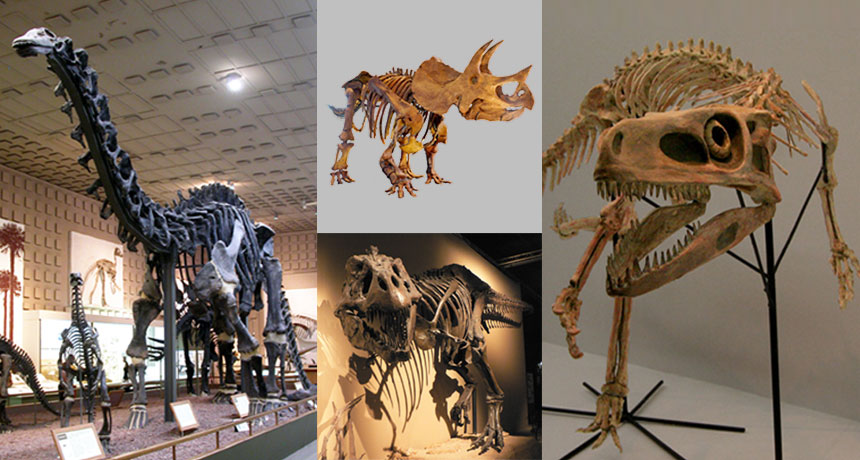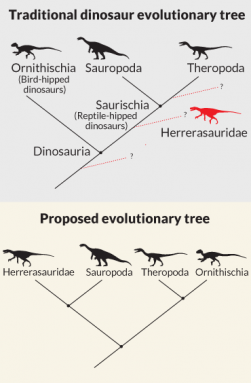Scientists are rethinking the dinosaur family tree
Proposal would radically alter century-old groupings of dinos

The dinosaur family tree just got a makeover. One outcome is a conclusion that meat-eating evolved twice in dinos (in groups represented by Tyrannosaurus rex, bottom middle, and Staurikosaurus, right). So did traits associated with plant-eating (groups represented by Brontosaurus, left, and Triceratops, top middle).
CLOCKWISE FROM LEFT: MATT WEDEL/WIKIMEDIA COMMONS (CC BY 4.0); ALLIE_CAULFIELD/WIKIMEDIA COMMONS (CC BY-SA 3.0); KABACCHI/WIKIMEDIA COMMONS (CC BY 2.0); DAVID MONNIAUX/WIKIMEDIA COMMONS (CC BY-SA 2.0 FR)
The standard dinosaur family tree may soon be just a relic.
A new study proposes redrawing that tree. Its authors argue that this made sense after examining more than 400 body traits.
The long-accepted tree of dino relationships has two main branches. Each contains critters familiar even to the non–dinosaur obsessed.
One branch leads to the “bird-hipped” ornithischians (Or-nih-THISH-ee-uns). This group includes the plant-eating duckbills, stegosaurs and Triceratops. Another branch contains the “reptile-hipped” saurischians (SOR-ish-ee-uns). That group is further divided into two smaller ones. There are the plant-eating sauropods (typically four-legged, like Brontosaurus). And then there’s the meat-eating theropods. (They are typically two-legged, like Tyrannosaurus rex and modern birds.)
Harry Seeley first proposed this split between bird-hipped and reptile-hipped dinos in 1887. The British paleontologist had noticed that the pelvis of every dino had one of these two shapes. At some point, he reasoned, the earliest dinos must have diverged into these two groups. Other scientists accepted the idea, and then strengthened it in the 1980s. It essentially has been dogma ever since.

Now a group of researchers has re-examined dinosaur anatomy with fresh eyes. And they come to a very different conclusion — and tree.
Matthew Baron is a paleontologist in England. He works at the University of Cambridge and Natural History Museum in London. His team started with a mix of fossils, photos and descriptions from scientific papers. The researchers pored over the anatomy of more than 70 different dinosaurs and close non-dino kin. Overall, they compared 457 aspects of their anatomy. They tallied the presence, absence and types of features. These might include the shape of a hole on the snout or a cheekbone ridge. Those data were fed into a computer program. It generated a family tree that grouped animals that shared certain specific features.
Baron’s group now describes that new din family tree in the March 23 Nature.
Repositioning the branches
The tree shows four groups atop two main branches. Bird-hipped dinos used to live on their own lone branch. Now they share one with reptile-hipped theropods, such as T. rex. This placement suggests the once-distant cousins were actually closely related.
It also reinforces existing questions about bird-hipped dinos. They are an oddball group with murky origins. They appear late in the fossil record for dinosaurs and then appear everywhere. Some scientists had suggested that they evolved from an existing group of dinos. This might have been a group of similarly plant-eating sauropods. But now placing bird-hipped dinos next to theropods changes this thinking. The new tree hints that the late-to-the-party vegetarian weirdos could have evolved from the meat eaters.
Sauropods (such as Brontosaurus) no longer sit next to theropods. They now reside on a branch with the meat-eating herrerasaurids (Heh-RAER-ah-SOR-ids). This is a confusing group. Some scientists think herrerasaurids belong near the other meat eaters, the theropods. Others question whether herrerasaurids are even dinosaurs at all.
Many of the earliest dinos had grasping hands and a mix of meat-eating and plant-eating teeth. That implies they were omnivores, eating both. If true, the new four-pronged tree suggests that vegetarians and meat eaters each evolved twice in dino history.
How controversial is this reshaping of the dino tree?
Upon seeing the new computer-generated tree, “We were very surprised — and cautious,” notes Baron. “It’s a big change,” he admits, and “flies in the face of 130 years of thinking.”
Randall Irmis is a paleontologist at the Natural History Museum of Utah and the University of Utah in Salt Lake City. He thinks this proposed reshaping of the dino tree “is a novel proposal and a really interesting hypothesis.” He agrees there is “a possibility” that it reflects actual dino relationships. However, he also cautions, “It goes against our ideas of the general relationships of dinosaurs. It’s certainly going to generate a lot of discussion.”
The new tree suggests that dinosaurs shouldn’t be grouped just on the basis of one obvious trait, such as the shape of the pelvis. “The relationships are read in the minutiae [tiny traits], not big horns and frills,” says Kevin Padian. He’s a paleontologist at the University of California, Berkeley. He wrote an assessment of the research that also appears in Nature.
That said, Padian isn’t certain that the new tree reflects reality. Such trees are based on how scientists interpret anatomical features. Are some holes in the bones similar in size or somewhat different? Are angles in the same direction or not? These are decisions that will surely be quibbled with, Padian says. “The devil is in the details.”
Still, he admits, “These guys have done their homework and now everyone’s going to have to roll up their sleeves and start checking their work.”







